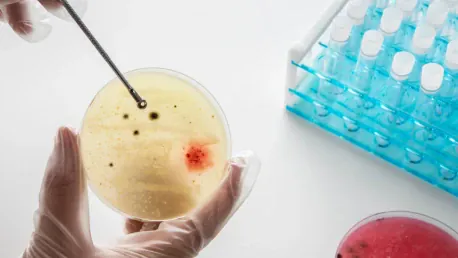The global cell culture vessels market is on a remarkable growth trajectory, projected to expand from an estimated USD 4.90 billion in 2023 to over USD 19.65 billion by 2033. This significant growth, at a robust CAGR of 14.9% from 2024 to 2033, underscores the critical role of cell culture technologies in advancing medical research and treating chronic diseases. The increasing demand for cell-based therapies, coupled with major investments in research and development, highlights the urgent need for advanced cell culture vessels, driving the market forward.
Regional Market Insights
North America’s Market Leadership
North America is leading the cell culture vessels market, holding a 40.19% share in 2023. This dominance is attributed to the region’s advanced healthcare infrastructure, substantial R&D investments, and a thriving biopharmaceutical industry. The presence of cutting-edge technologies and a supportive regulatory environment further propels market growth in this region.
The extensive use of cell culture vessels in drug production and discovery, coupled with the region’s focus on innovation, positions North America as a key player in the global market. The region’s commitment to healthcare advancements ensures sustained growth and development in the cell culture vessels sector. Moreover, the increasing prevalence of chronic ailments, such as diabetes and cancer, emphasizes the necessity for more effective research tools and therapeutic solutions, reinforcing this region’s stronghold in the market.
Asia Pacific’s Rapid Growth
The Asia Pacific region is exhibiting the highest CAGR of 17.84% during the forecast period. This rapid growth is driven by increasing demand for regenerative medicines, significant advancements in healthcare infrastructure, and substantial investments in pharmaceutical and biotechnology research. With a booming population and rising incidences of chronic diseases, the region is experiencing significant demand for innovative cell culture solutions.
Countries like China and India are at the forefront of this growth, with their expanding healthcare sectors and rising focus on biopharmaceutical research. The region’s growing population and increasing prevalence of chronic diseases further fuel the demand for advanced cell culture technologies. Additionally, government incentives and strategic partnerships between local and global biotech firms contribute to a robust growth landscape, enhancing the region’s potential in the cell culture vessels market.
Market Segmentation by Product
Bags: Cost-Effective and User-Friendly
In 2023, the bags segment holds a 39.81% market share, favored for its cost-effectiveness, reduced contamination risks, and ease of use. The increasing preference for single-use bags is a major growth driver, as they offer significant advantages in terms of operational efficiency and contamination control. Laboratories and research facilities are increasingly adopting these bags for their simplicity and reliability in various applications.
Single-use bags are particularly popular in laboratory settings, where they are used for various applications, including cell growth and maintenance. Their convenience and reliability make them a preferred choice for researchers and healthcare professionals. As pharmaceutical and biotechnology companies continue to seek efficient and secure ways to conduct their research, the adoption of single-use bags is expected to rise significantly, further driving the market.
Flasks: Essential for Laboratory Applications
Flasks are expected to register significant growth in the coming years. These vessels are essential in laboratory settings for various applications, including experimentation and cell growth maintenance. Their durability and versatility make them indispensable tools in cell culture research. As personalized medicine and regenerative therapies continue to gain traction, the demand for reliable and versatile cell culture tools like flasks is projected to grow.
The increasing focus on personalized medicine and regenerative therapies is driving the demand for flasks, as they play a crucial role in the development and testing of new treatments. The growing need for advanced research tools ensures steady growth for this segment. Researchers and pharmaceutical companies are investing in advanced flask technologies to achieve more precise and reproducible results, further expanding the segment’s market share.
Market Segmentation by Type
Single-Use Vessels: Dominating the Market
Single-use vessels dominate the market with a 70.98% share in 2023. These vessels are preferred due to their lower operational costs and reduced contamination risks. The convenience and efficiency of single-use technologies make them an attractive option for researchers and healthcare providers. As more laboratories realize the benefits of these vessels, their adoption is expected to continue its upward trend.
The growing trend towards single-use systems is driven by the need for cost-effective and reliable solutions in cell culture research. As the demand for advanced medical treatments continues to rise, single-use vessels are expected to maintain their market dominance. Innovations in single-use technologies and their scalability for different research applications are further supporting this growth, enabling better research outcomes and operational efficiencies.
Reusable Vessels: Long-Term Cost Efficiency
Reusable vessels are recognized for their long-term cost efficiency and durability. These vessels are ideal for large-scale applications, where their robustness and reliability are crucial. Although their growth rate is moderate compared to single-use vessels, they remain an important segment in the market. Their eco-friendly nature and suitability for extensive use in large research and manufacturing facilities underscore their continued relevance.
The use of reusable vessels is particularly prevalent in large research institutions and pharmaceutical companies, where the focus is on long-term sustainability and cost management. Their continued relevance in the market highlights the need for diverse solutions in cell culture research. As sustainable practices gain more importance, industries are likely to balance between single-use and reusable vessels, based on specific research needs.
Market Segmentation by End-Use
Pharmaceutical & Biotechnology Companies: Leading the Market
Pharmaceutical and biotechnology companies hold a 47.09% market share in 2023. This segment leads due to the extensive use of cell culture vessels in drug production and discovery. The ongoing development of new therapies and treatments drives the demand for advanced cell culture technologies. The relentless pursuit of innovative treatments for chronic diseases fuels this segment’s dominance in the market.
The increasing prevalence of chronic diseases and the focus on personalized medicine are key factors contributing to the growth of this segment. As pharmaceutical and biotechnology companies continue to innovate, the demand for cell culture vessels is expected to rise. Collaborations between academia and industry are further propelling research activities, fostering innovation, and pushing the frontiers of new drug development.
CMOs & CROs: Fastest Growing Segment
Contract Manufacturing Organizations (CMOs) and Contract Research Organizations (CROs) are projected to grow at the fastest rate. This segment benefits from the increasing outsourcing of research and manufacturing by pharmaceutical and biotechnology companies. The need for specialized expertise and cost-effective solutions drives the demand for CMOs and CROs. These organizations play an essential role in enhancing the capabilities of pharma and biotech firms by providing crucial research and production support.
The growing trend towards outsourcing in the biopharmaceutical industry highlights the importance of CMOs and CROs in the market. Their role in supporting research and production activities ensures continued growth and development in the cell culture vessels sector. As companies strive to optimize resources and focus on core competencies, the reliance on CMOs and CROs is expected to strengthen, further boosting market growth.
Market Growth Drivers
Clinical Trials & Research: A Primary Driver
The surge in clinical trials for cell-based therapies and increased R&D investments are primary growth drivers. With the healthcare industry continually seeking novel treatments and drug discoveries, the need for advanced cell culture vessels becomes more pronounced. Clinical trials require precise and reliable tools, making cell culture vessels indispensable in these critical research phases.
Chronic Disease Prevalence
The rising incidence of chronic diseases such as diabetes and cancer fuels the demand for cell culture technologies. As the population continues to age and lifestyles evolve, the prevalence of chronic conditions necessitates ongoing advancements in therapeutic approaches, further driving the market for cell culture vessels.
Personalized Medicine and Technological Advancements
The focus on personalized therapies and regenerative medicine stimulates innovation in cell culture technologies. Personalized medicine aims to tailor treatments based on individual patient profiles, making accurate and efficient cell culture processes essential.
Technological advancements in cell culture technologies enhance the efficiency and applicability of cell culture vessels in research and production environments. Continuous innovation ensures that cell culture vessels meet the evolving needs of the biotechnology and pharmaceutical industries, enabling more effective research and production processes.
Conclusion
The global cell culture vessels market is experiencing remarkable growth, with projections suggesting an increase from an estimated USD 4.90 billion in 2023 to more than USD 19.65 billion by 2033. This translates to a robust compound annual growth rate (CAGR) of 14.9% from 2024 to 2033. This significant expansion emphasizes the pivotal importance of cell culture technologies in advancing medical research and developing treatments for chronic diseases.
The demand for cell-based therapies is on the rise, driven by the growing prevalence of chronic conditions that require advanced and innovative treatment solutions. In response, major investments are being made in research and development to refine and enhance cell culture technologies. This increased focus on R&D underscores the urgently growing need for advanced cell culture vessels, which are essential for cultivating cells in a controlled environment and achieving reliable results.
Moreover, cell culture plays a fundamental role in various applications, including cancer research, regenerative medicine, and pharmaceutical development. The development of new and improved cell culture vessels is crucial for supporting these applications. As a result, companies in the biotechnology and pharmaceutical industries are dedicating substantial resources to innovate and improve cell culture systems.
Overall, the cell culture vessels market is set to see substantial growth due to the rising demand for advanced medical research tools and treatments, significant investments in R&D, and the intrinsic value of cell culture technologies in modern medicine.









